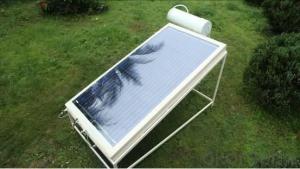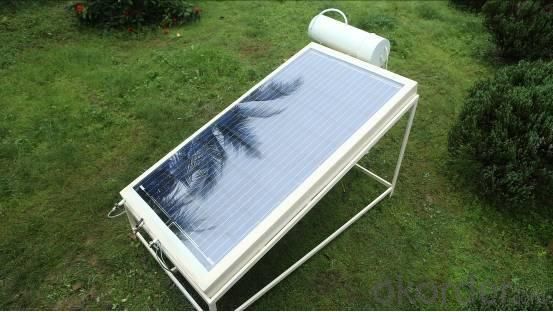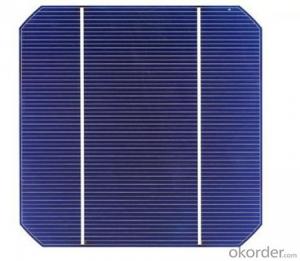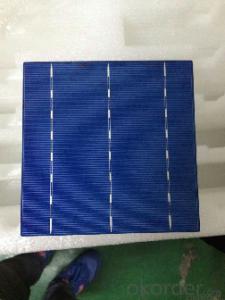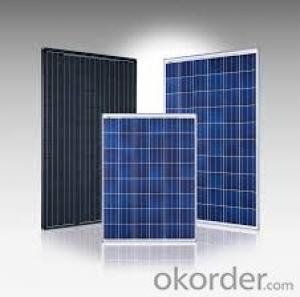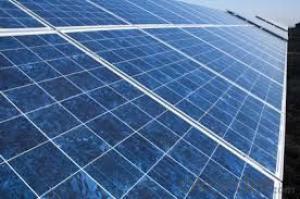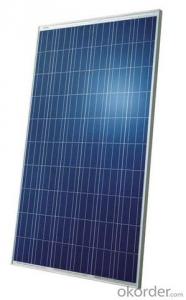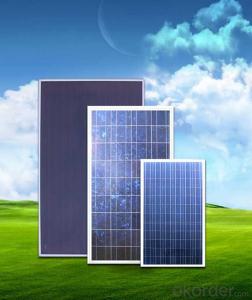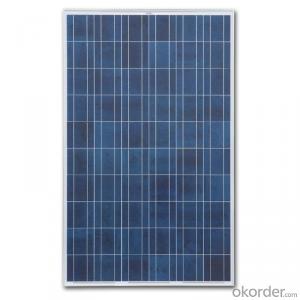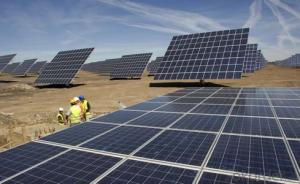Nanotube Solar Cells Polycrystalline Solar Panel with Factory Price CNBM In Stock
- Loading Port:
- Qingdao
- Payment Terms:
- TT OR LC
- Min Order Qty:
- 10 set
- Supply Capability:
- 300000 set/month
OKorder Service Pledge
OKorder Financial Service
You Might Also Like
Polycrystalline Solar Modules
CNBM offers a range of small, medium and large polycrystalline solar modules, designed for a range of requirements.
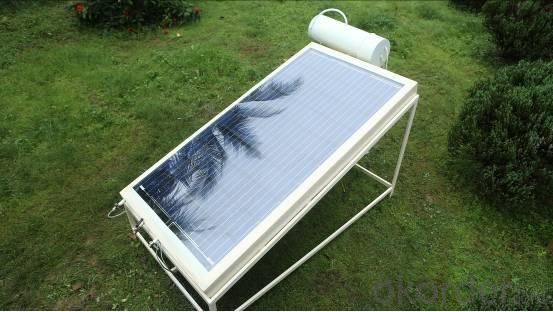
Specifications:
Tolerance | +/-3% |
Cell | Polycrystalline silicon solar cells (156 x 156mm) |
N0. of Cells | 60 (0 x 6) |
Dimension of Modules (mm) | 1650 x 990 x 40 |
Weight (kg) | 25.5 |
Limits:
Operating Temperature | -40~+85? |
Storage Temperature | -40~+85? |
Maximum System Voltage | 1000 VDC max. |
Hail Impact | Diameter of 28mm with impact speed |
Temperature and Coefficients:
NOCT | 48C+/-2? |
Voltage temperature coefficient (%/K) | -0.35 |
Current temperature coefficient (%/K) | 0.05 |
Power temperature coefficient (%/K) | -0.45 |
Characteristics:
Model: | SGM-200P | SGM-210P | SGM-220P |
Max-power voltage Vmp (V) | 29.2 | 29.4 | 29.41 |
Max-power current Imp (A) | 6.85 | 7.14 | 7.48 |
Open-circuit voltage Voc (V) | 36.5 | 36.69 | 36.9 |
Short-Circuit Current Isc (A) | 7.28 | 7.6 | 7.93 |
Max-power Pm(W) | 200 | 210 | 220 |
Model: | SGM-230P |
Max-power voltage Vmp (V) | 29.8 |
Max-power current Imp (A) | 7.72 |
Open-circuit voltage Voc (V) | 37.31 |
Short-Circuit Current Isc (A) | 8.19 |
Max-power Pm(W) | 230 |
STC: Irradiance 1000W/m2, module temperature 25?, AM-=1.5
Poly Crystalline Solar Panels Specifications Range
Maximum Power (Pm) | Dimension | Weight | Operating Voltage (Vmp) | Operating Current (Imp) | Open Circuit Voltage (Voc) | Short Circuit Current (Isc) |
0.45W | 140x80x10mm | 0.08kg | 3.3V | 150mA | 4.6V | 160mA |
1.0W | 162x140x10mm | 0.16kg | 7.5V | 150mA | 10.3V | 160mA |
4.5W | 269x251x23mm | 0.8kg | 16.5V | 0.27A | 20.5V | 0.3A |
10W | 420.1×268.9×22.6mm | 1.92kg | 17.5V | 0.58A | 20.5V | 0.6A |
20W | 425x502x50mm | 3.0kg | 16.8V | 1.19A | 21.0V | 1.29A |
30W | 593x502x22.6mm | 3.9kg | 16.8V | 1.78A | 21.0V | 1.94A |
40W | 655x537x50mm | 5.75kg | 17.3V | 2.31A | 22.1V | 2.54A |
50W | 839x537x50mm | 6.0kg | 17.5V | 2.9A | 21.8V | 3.17A |
65W | 1111x502x50mm | 7.2kg | 17.6V | 3.69A | 22.1V | 3.99A |
80W | 1204x537x50mm | 7.7kg | 17.6V | 4.55A | 22.1V | 4.8A |
- Q: Can solar cells be used in developing countries?
- Yes, solar cells can be used in developing countries. They offer a sustainable and renewable source of energy that can be harnessed even in remote areas without access to electricity grids. Solar cells can provide clean and affordable electricity, helping to improve living conditions, foster economic growth, and reduce dependence on fossil fuels. Additionally, the decreasing costs and increasing efficiency of solar technology make it an increasingly viable option for developing countries.
- Q: Have you ever been to a solar cell power generation station?
- I know a company named SUNPOWER is famous for that.
- Q: How do solar cells generate electricity at night?
- Solar cells do not generate electricity at night as they rely on sunlight to produce energy.
- Q: How do solar cells perform in areas with high levels of noise pollution?
- Solar cells are not affected by noise pollution as it has no impact on their performance. Noise pollution does not interfere with the ability of solar cells to convert sunlight into electricity, making them a reliable energy source even in areas with high levels of noise pollution.
- Q: Is that true that the price of solar cells will be reduced in the coming year?
- TrendForce, a professional survey firm based in Taiwan announced March 10th : because the global market demand for solar cells is declining it is very possible that the price of solar will eventually goes down.
- Q: Can solar cells be installed on curved surfaces?
- Yes, solar cells can be installed on curved surfaces. Flexible solar panels have been developed which allow for installation on various curved surfaces such as vehicles, boats, or even building facades. These flexible panels are made using thin-film technologies that enable them to conform to curved shapes while still generating electricity from sunlight.
- Q: How do solar cells handle voltage fluctuations?
- Solar cells do not handle voltage fluctuations directly. However, to manage voltage fluctuations, additional components such as voltage regulators or inverters are used in conjunction with solar cells. These components help stabilize and regulate the voltage output from solar cells to ensure consistent and reliable power supply.
- Q: Can solar cells power an entire house?
- Yes, solar cells have the potential to power an entire house. With advancements in technology and proper installation of solar panels, it is possible to generate enough electricity to meet the energy needs of a household. However, the feasibility of this depends on various factors such as the size of the solar panel system, the energy consumption of the house, and the availability of sunlight in the area.
- Q: Does solar cell cost less than the other power generation technology?
- Yes, it cost much less than the traditional power generation technology.
- Q: Can solar cells be used in cloudy or rainy conditions?
- Yes, solar cells can still be used in cloudy or rainy conditions, although their efficiency may be reduced. Cloudy or rainy weather reduces the amount of sunlight available for the solar cells to convert into electricity. However, modern solar cells are designed to still generate power even in low light conditions, although their output may be significantly lower compared to sunny conditions.
Send your message to us
Nanotube Solar Cells Polycrystalline Solar Panel with Factory Price CNBM In Stock
- Loading Port:
- Qingdao
- Payment Terms:
- TT OR LC
- Min Order Qty:
- 10 set
- Supply Capability:
- 300000 set/month
OKorder Service Pledge
OKorder Financial Service
Similar products
Hot products
Hot Searches
Related keywords
